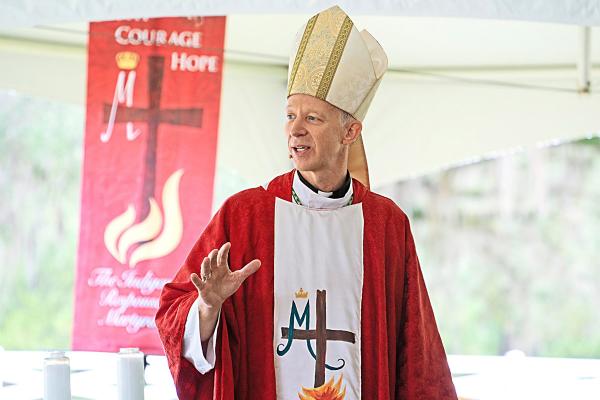
For several years, lay Catholics and clergy have researched, chronicled and verified a piece of Florida's Catholic history from more than three centuries ago in hopes it will become a piece of Catholic history for the universal Church.
Now, eight years after this process officially began, a Mass recently marked the affirming, signing and sealing of documentation on the Martyrs of La Florida Mission — Antonio Inija and 57 companions — to be delivered to the Dicastery for the Causes of Saints in Rome for consideration of canonization.
The group of nearly 60 who were martyred in the name of God from 1549 to 1712 included Catholics who were Indigenous, many of the Apalachee tribe, in what is present-day Florida and missionaries who came to the region from other lands.
In November, Msgr. Michael Reed, chancellor of the Pensacola-Tallahassee Diocese, will escort the documents to Rome to deliver to the dicastery.
"They are not from some far-off lands. They are from this land right here. Maybe even this land where we are literally standing upon is where they spilled their blood, offered their blood for the Lord," Bishop William A. Wack of Pensacola-Tallahassee said of these martyrs in his homily during a Mass celebrated at a site along El Camino Real in rural Tallahassee. "We are proud of that. Proud we can lift them up and make them known to the whole world."
Some 650 supporters, including members of Indigenous tribes, gathered for the Oct. 12 Mass, which marked the closing of the diocesan phase and the beginning of the Vatican phase of the cause.
"It is our hope they are declared martyrs by Rome because we want the whole world to be inspired by them … so that little children can read about them and stir their hearts like mine as they live for the Lord," said the bishop, who recounted reading about stories of different martyrs from across the world who gave the ultimate sacrifice to proclaim the Lord. He said those stories stirred his young heart.
The cause of the Florida martyrs unites nine dioceses, including six Florida dioceses — Pensacola-Tallahassee, St. Augustine, Venice, Orlando, St. Petersburg and Palm Beach — along with the Archdiocese of Mobile, Ala., and the dioceses of Savannah, Ga., and Richmond, Va.
Since the site of the massacre of the lead martyr — Antonio Inija — occurred on the grounds within the Pensacola-Tallahassee Diocese, the eight other dioceses transferred the signing responsibilities to Bishop Wack.
The cause documents the historical accounts of what occurred, especially during the 1704 massacre when Inija and other Indigenous were captured, killed and, in some cases tortured, by Col. James Moore, governor of Carolinas, and his Creek allies in the name of Queen Anne of England.
The atrocious massacre offers further evidence that the missionaries established missions, not slave camps, among the Indigenous. While the Spanish fought side-by-side with Apalachees against the aggressors, there was not a large Spanish military force present to aid in opposing the English aggression.
"When the Indigenous were captured, they were given the opportunity to defame their faith and they chose horrible deaths rather than capitulating to denying the faith," Father Len Plazewski, one of the cause's five vice postulators, explained to the Florida Catholic in 2022.
"Col. Moore went from mission to mission, wiping out all he could and took Native peoples who could not escape as slaves. … Col. Moore hated Catholics with a passion. The fact was that he did fight to advance the British Empire, but he was also attacking people he hated," the priest said. "It was in present terms 'human rights abuses,' with his motivation coming from his hatred of the Catholic Church and Catholic faith. He wasn't trying to make allies among people; he was trying to subjugate them."
When Inija was captured, he was tortured by Moore's forces. He and others were tied to stakes and their feet were set on fire when they refused to renounce their faith.
Please read our Comments Policy before posting.
Article comments powered by Disqus Vietnamese youth group brings martyr’s story to life
Vietnamese youth group brings martyr’s story to life
 Jesus shared personal details with 3 best friends
Jesus shared personal details with 3 best friends
 Church noting modern-day Christians who died for faith
Church noting modern-day Christians who died for faith
 Bishop Malone gives update on 'Shreveport martyrs' cause
Bishop Malone gives update on 'Shreveport martyrs' cause
 St. Stephen, a hero of The Grateful Dead?
St. Stephen, a hero of The Grateful Dead?
 Don’t let misconceptions cause faith to waver
Don’t let misconceptions cause faith to waver
 Seniors, whatever storms may come, Jesus will be there
Seniors, whatever storms may come, Jesus will be there
 Studio 3:16 offers new approach to teaching religion
Studio 3:16 offers new approach to teaching religion
 After three decades, NLR principal plans to retire
After three decades, NLR principal plans to retire
 CHS athlete overcomes odds to reach collegiate goal
CHS athlete overcomes odds to reach collegiate goal
 St. Joseph a model of solidarity with immigrants
St. Joseph a model of solidarity with immigrants
 Two gifts after Jesus’ death: Virgin Mary and Eucharist
Two gifts after Jesus’ death: Virgin Mary and Eucharist
 Why we have an altar, and not just a communion table
Why we have an altar, and not just a communion table
 Pope: Wars should be resolved through nonviolence
Pope: Wars should be resolved through nonviolence
 Living relationship with Jesus Christ in the Eucharist
Living relationship with Jesus Christ in the Eucharist